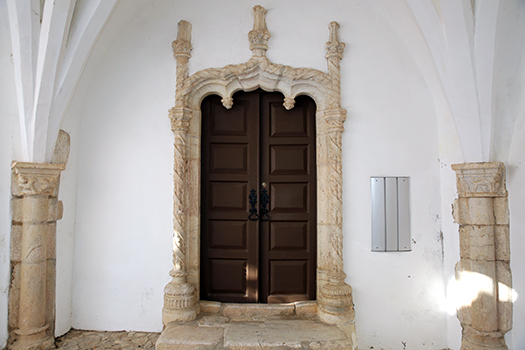 |
The portal, in front of which is thought to be the location of the Town Hall in the 16th century, was carved in limestone from the region and consists of a multifoil arcade decorated with spheres, ropes and knots (Manueline style decorative elements) and topped with stylized artichokes, according to the decorative taste of the Arruda brothers (Diogo and Francisco de Arruda).
It has a rectangular plan, with a single nave with a ribbed vault, a main chapel, a sacristy, a high choir, a pulpit and a masonry bench that runs along the northern façade, but it no longer has the choir stall where the Misericórdia’s administrators (Bureau members and Head Master) attended the religious ceremonies, a piece that in some Misericórdia churches reaches high artistic value.
The main chapel, separated from the church by a triumphal arch, is of quadrangular plan and has a multi-ribbed vault, garnished with cylindrical phytomorphic ornaments, representative of the Portuguese art exoticism of the end of the Gothic style.
The body of the church and the main chapel were clad in tiles, in carpet-style pattern, polychrome, in the 17th century, presumably shortly after a campaign of works concluded around 1644, when the church of Nossa Senhora da Anunciação (Our Lady of Annunciation) also received a coating of tiles. Curiously, the church of Misericórdia’s tiles have an excessive number of manufacturing defects, which indicates that, eventually, rejected tiles from the parish church were used. This coating was an addition to the initial design, for the decorative beauty, durability, and eventually with the intention of improving the building’s healthiness, since the problems of infiltration and humidity were a constant since the 16th century. This circumstance, due to the fact that the building is partially below ground level, meant that in 1558 the original altarpiece was already lost and motivated the plan, that year, of transferring the church to the square. A change that had not yet taken place in 1572, and the idea was abandoned in 1573, proposing, instead, that the "house" of the Misericórdia was elevated. Since there is no further information on this matter and the one that subsists is sometimes not very clear in its content; and the fact that the configuration of the Misericórdia facilities at the time is not exactly known, we are in doubt as to whether the referred lifting works took place at that time or not. As far as the church is concerned, the implantation spot must be the original one. With regard to a possible annexed space, where the meetings of the Bureau took place, depends on the reality of the documented records referring to the "house" in Misericórdia. "Lifting higher" could mean raising the ground level or building a first floor. In fact, we know that the building annexed to the church had an upper floor, with divisions, but Túlio Espanca refers that they come back to the 18th century, where the administrative table gathered and where the archive, the library and the cereals received from rents and property charters were stocked. We do not know, however, if between the endings of the 16th and the 18th centuries were no other phases of works, following what was determined in 1573.
In the old sacristy there is a marble washbasin, according to Espanca, in 1688 at the expense of Provedor Dr. Domingos Coelho Reidono.
The pulpit, with a square marble base, has iron balusters, which were made, according to Espanca, in the 1670s thanks to alms granted by the archbishop of Évora, D. Diogo de Sousa.
In the first decades of the 18th century, a new altarpiece was commissioned for the main chapel, which caused the mural painting to be sacrificed - which complemented the decorative campaign of applying the tiles - and forced the reconfiguration of the carpet tiles while maintaining the original ones. This baroque altarpiece, made of wood, with the canvas of the Visitation, was never golden.
In the second half of the 19th century, to help differentiate the space destined for the Bureau members and the Misericórdia’s Head Master, part of the tiles of the church’s southern façade were removed for the execution of a mural painting with a geometric pattern that framed the then existing choir stall. The removed tiles were probably carelessly transferred to the mirror of the bench that stands on the northern façade.
At an unidentified date a few tiles were removed from the upper choir coating.
In the nave’s pavement are several graves of brothers of the Misericórdia from the 16th century and later.
Above the church, from the portico to the western tower, functioned the former headquarters of the Misericórdia, whose building disappeared in the seventies, first because of ruin and then because of the rebuilding works of the castle.
Protection: Included in the Protection Zone of the Castle and the Main Church (Matriz).
REFERENCES
Arquivo da Santa Casa da Misericórdia de Viana do Alentejo, Santa Casa da Misericórdia de Viana do Alentejo, Testamentos, Liv01 (PT/ASCMVNT/SCMVNT/B/06/Liv01-1688)
ESPANCA, Túlio, Inventário Artístico de Portugal: Distrito de Évora: Concelhos de Alandroal, Borba, Mourão, Portel, Redondo, Reguengos de Monsaraz, Viana do Alentejo e Vila Viçosa, Lisboa, Academia Nacional de Belas-Artes, 1978,Tomo IX, Vol. 1.
MANGUCCI, Celso e ZAGALO, Assunção, “Os azulejos da igreja da Misericórdia de Viana do Alentejo: identificação das patologias e proposta de intervenção”, Património Estudos, nº 7, 2004, pp. 146-150.
PAIS, Ana Cristina, “Projecto de recuperação, conservação e valorização do Castelo de Viana do Alentejo”, Património Estudos, nº 7, 2004, pp. 133-137.

 Abrir Lista
Abrir Lista MUNICÍPIO DE VIANA DO ALENTEJO
MUNICÍPIO DE VIANA DO ALENTEJO